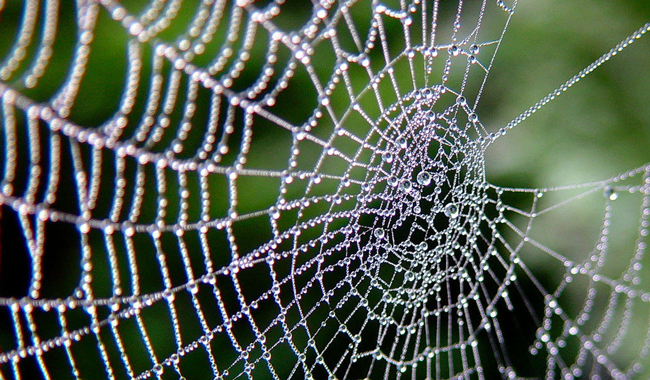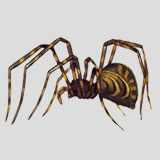How Do They Do That? – Spider Webs
By Chris Williams on August 20, 2013.

We’ve all marveled at the intricacy, beauty, and efficiency of a spider’s web. We’ve all cursed when we accidentally walked through one.
It’s the large orb webs spun by garden spiders that capture the most attention. In late summer, these webs seem to become more abundant across our porches or decks, often wherever there are outdoor lights that attract insects. The spider can spend hours methodically constructing her circular orb, attaching it with silken guy lines to a couple of supports. The spider hangs in the center of the web and waits for a flying insect to hit the silk. Then she wraps her victim with silk and stores it in her web to eat later.
Spider webs are designed to either capture and hold the prey, or just slow it down long enough for the nearby spider to grab it. Not every spider spins webs and not every spider that spins a web spins the circular, symmetrical orb that typifies a spider’s web. Some spiders make a scaffold style web of random silk strands in no particular pattern or shape. Some spiders wait in a burrow with only a few strands of silk across the opening. When an insect touches the silk and sets off an alarm vibration, the spider rushes out of its burrow to grab the prey. Others wait below flat sheets of silk or inside silken funnels that insects literally stumble onto. The bolas spider even slings a silken bola with a sticky glob on its end to take down prey, while another spider makes a tiny silken net and drops it on its chosen meal.
Silk Isn’t Just for Hunting
Spiders also spin silk to attach a dragline, to cover their egg sacs, to wrap and hold captured prey, to line their burrows, and even to wrap the female before mating. Spiders also leave a silken line wherever they go. You’ve probably noticed if you try to brush a spider off, it just drops down on a dragline that it extrudes from its abdomen and then climbs right back up. This silken lifeline allows the spider to survive falls, escape enemies by safely dropping out of sight, and use breezes to move to a new location. Newly hatched spiderlings can “balloon” great distances on their silken tethers if they can catch a breeze.
How Do Spiders Produce Silk?
Silk is a liquid protein extruded from “spigots” atop three pairs of spinnerets on the spider’s abdomen. Each silk fiber is composed of two strands, one from each of a pair of spinnerets. The silk comes out as a liquid and quickly hardens to form threads. Some of the orb weavers even have a so-called valve that can control the diameter of the silk strands they spin, while others can produce more than one variety of silk, depending on its purpose.
Scientists have long studied spider silk, admiring its extraordinary strength and resiliency and looking for ways to utilize artificial silk in medicine and as a replacement for bullet-proof Kevlar®, among other things. Spider silk is used for the cross hairs in rifle scopes and for the sighting marks in engineering and laboratory instruments. Spider silk has a tensile strength greater than that of steel, and is more elastic, lighter in weight, and more durable than any fiber on the market.
Photo credit: josef.stuefer / Foter / CC BY
